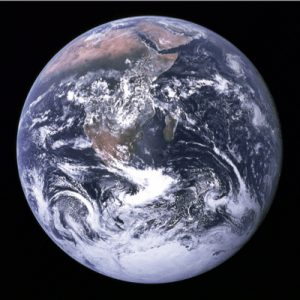New laser-based compression experiments by Lawrence Livermore National Laboratory (LLNL), Bayreuth University, and the University of California, Berkeley, have recreated conditions of cores of super-Earths, planets with masses five times that of the Earth.

Researchers have re-created conditions of ‘super-Earths’ in the lab, planets with masses five times that of the Earth.
Source: Wikimedia Commons
Through a combination of laser-driven shock compression, a technique that uses lasers to send a strong decaying shock through a material, and ultrafast diagnostics, the scientists were able to place silica at 500 GPa, a pressure similar to the core mantle boundary pressure for a super-Earth planet, and measure the melting temperature (1). Shock compression causes the temperature of silica to rise as the increased pressure from the compressions causes an increase in internal energy (2).
The high pressure, density, and temperature inside of planet cores can alter the properties of materials (1). Being able to study certain materials, such as silica, under similar conditions to vital to understanding internal planet structure and formation.
When silica along with stishovite was shock-compressed above ~10,000 K, a temperature comparable to the melting temperature of liquid iron at a similar pressure, it began to transition to an electrically conducting state (2). This suggests that rocky planets able to sustain core pressures between 300-500 GPa may have had oceans of molten rock at their cores (1).
Such liquid-rock layers can form planetary magnetic fields, which are important in deflecting solar winds and maintaining an atmosphere (1). Magnetic fields also provide insight into planet dynamics (2).
This research also suggests that silica and magnesium oxide are within the deep interior of Uranus, Neptune, and other large icy planets. Scientists hypothesize that they are also in the solid cores of Saturn and Jupiter (2).
Bayreuth University in Germany made the experiment possible by supplying polycrystals and stishovite— a high-density form of silica (SiO2)— that is typically only found in small amounts near meteor craters (1). The stishovite is critical to the experiment: it stays cooler under shock compression and allows the team to measure the melting temperature at a higher pressure (1).
Millot and his colleagues plan to continue to study the strange behavior of materials using dynamic compression. Further advances may contribute towards a better understanding of planet formation and the origin of life (1).
Sources:
1. DOE/Lawrence Livermore National Laboratory (22 Jan 2015) New research re-creates planet formation, super-Earths and giant planets in the laboratory. ScienceDaily. Retrieved January 23, 2015 from http://www.sciencedaily.com/releases/2015/01/150122145418.htm
2. DOE/Lawrence Livermore National Laboratory (23 Jan 2015) Shock compression of stishovite and melting of silica at planetary interior conditions. ScienceMag. Retrieved Jaunary 25, 2015 from http://www.sciencemag.org/content/347/6220/418.full